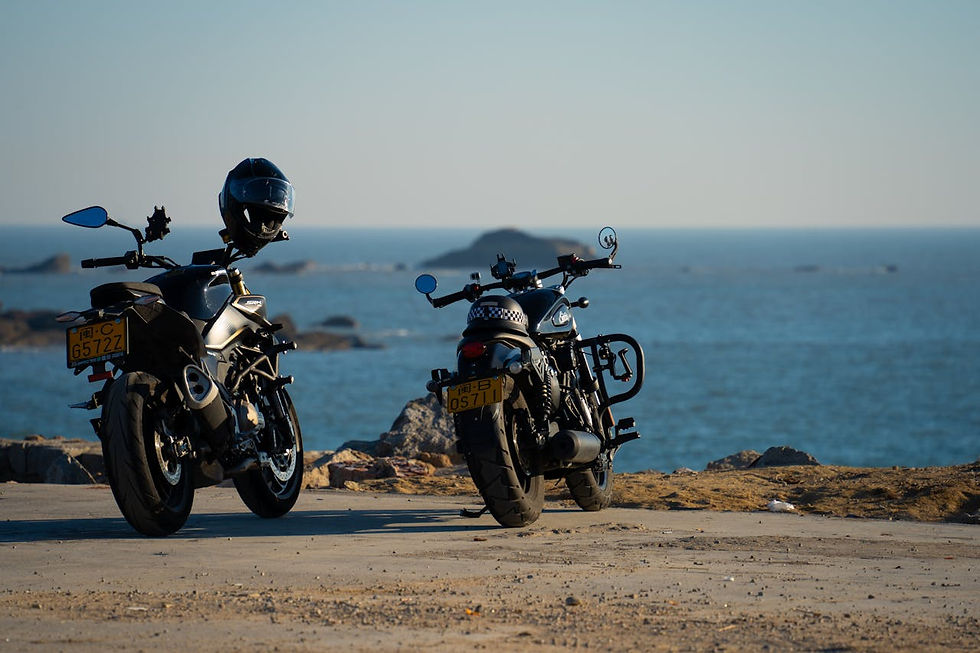The Grip of the Road: How Motorcycle Tires Maintain Traction
- Animesh Roy
- Mar 29, 2024
- 3 min read

The relationship between a motorcycle and the road is defined by one crucial element: traction. Traction is what keeps riders connected to the road, allowing for precise control, stability, and safety. At the heart of this connection are motorcycle tires. In this article, we'll delve into the mechanics of traction and explore how motorcycle tires maintain grip on the road.
Understanding Traction
Traction is the frictional force between the tires of a motorcycle and the surface of the road. It's what prevents the tires from slipping or skidding during acceleration, braking, and cornering. Without sufficient traction, a motorcycle would struggle to maintain control, especially in adverse weather conditions or on uneven road surfaces.
The Anatomy of Motorcycle Tires
To understand how motorcycle tires maintain traction, let's first examine their construction:
Tread Pattern:
The tread pattern of a tire plays a crucial role in determining its traction capabilities. Tread designs vary depending on the intended use of the tire, with some patterns optimized for grip on dry roads, while others are designed to channel water away in wet conditions.
Rubber Compound:
The rubber compound used in a tire affects its grip and longevity. Soft rubber compounds provide excellent traction but wear out more quickly, while harder compounds offer better durability but may sacrifice some grip.
Contact Patch:
The contact patch is the area of the tire that comes into direct contact with the road surface. Maximizing the contact patch allows for greater traction and stability, especially during cornering and braking maneuvers.
Factors Affecting Traction
Several factors influence the traction of motorcycle tires:
Road Surface:
The condition of the road surface significantly impacts traction. Smooth, dry roads offer the most grip, while wet, oily, or debris-strewn surfaces can reduce traction and increase the risk of sliding or skidding.
Temperature:
Tire grip can vary depending on temperature. Cold temperatures can cause rubber to harden, reducing traction, while hot temperatures can cause tires to become too soft and lose grip.
Tire Pressure:
Maintaining the correct tire pressure is essential for optimal traction. Underinflated tires can reduce the size of the contact patch, while overinflated tires can cause the center of the tread to bulge, reducing grip on the sides of the tire.
Rider Input:
The actions of the rider, such as throttle control, braking, and leaning into corners, also affect traction. Smooth, controlled inputs help maximize traction and maintain stability.
Techniques for Maximizing Traction
Riders can employ several techniques to maximize traction and ensure a safe riding experience:
Proper Maintenance:
Regularly inspecting and maintaining motorcycle tires is essential for preserving traction. This includes checking tire pressure, tread wear, and overall condition.
Choosing the Right Tires:
Selecting tires that are appropriate for the intended riding conditions and style is crucial for maximizing traction. Sport touring tires offer a balance of grip and longevity, while sport tires prioritize performance and grip.
Riding Technique:
Practicing smooth, controlled riding techniques can help maximize traction. This includes gradual throttle and brake application, smooth cornering, and maintaining a relaxed grip on the handlebars.
Adjusting Riding Style:
Riders should adjust their riding style to suit changing road and weather conditions. This may involve reducing speed in wet or slippery conditions, increasing following distances, and avoiding sudden or aggressive maneuvers.
Motorcycle tires play a central role in ensuring adequate grip on the road, allowing riders to confidently navigate a variety of conditions and terrains. By understanding the mechanics of traction and employing proper maintenance and riding techniques, motorcyclists can enjoy the thrill of the ride while staying firmly connected to the road.
Ride Hard, Ride Safe!


